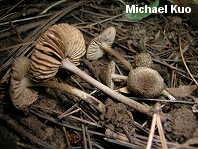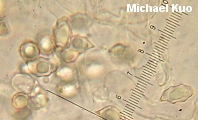| Major Groups > Gilled Mushrooms > Dark-Spored > Inocybe > Inocybe leptophylla |

|
Inocybe leptophylla [Basidiomycetes > Agaricales > Cortinariaceae > Inocybe . . . ] by Michael Kuo The easiest way to identify this scaly brown Inocybe, as I learned from a group of inebriated mycologists and mycology graduate students last summer, is to rub the stem repeatedly, spill Irish whiskey on it, and convince yourself that it bruised blue . . . so that you can call it "Inocybe calamistrata" without putting it under the microscope, and pour some more drinks. The more difficult, time-consuming route is to dry some of the mushrooms and study them with a microscope months later on a sober winter evening--and to concede the possibility that sobriety was bruised, rather than the stem. Distinctive features for Inocybe leptophylla include the habitat under conifers (on the ground or on rotting wood); the scaly, brown cap; the non-bruising stem; the lack of a distinctive odor; the nodulose spores; and the lack of pleurocystidia. It is very close to Inocybe lanuginosa, which has scattered pleurocystidia and slightly smaller spores. Inocybe casimiri is a synonym. Inocybe leptophylla var. cystomarginata was originally described by Atkinson (1918), who thought it differed on the presence of cheilocystidia, but contemporary investigators (Matheny & Kropp, 2001) "do not consider var. cystomarginata as an autonomous taxon." Description: Ecology: Mycorrhizal with conifers (possibly at least facultatively saprobic?); growing alone, scattered, or gregariously around rotting conifer stumps; usually growing from rotting wood but also terrestrial under conifers; spring, summer, and fall; widely distributed in North America. Cap: 1-4 cm; convex or conical at first, becoming broadly bell-shaped, broadly convex, or nearly flat; dry; scaly; dark brown by all accounts save the original description, which describes the cap as brunneo vel umbrino frequenter purpureo tincto ("brown or dark brown frequently tinted purple"). Gills: Attached to the stem, sometimes by a notch; close; pale brownish, becoming cinnamon brown or medium brown; at first covered by a quickly disappearing cortina. Stem: 2-5 cm long; up to about .5 cm thick; more or less equal; dry; silky and pale above; brown and hairy to scaly below; solid. Flesh: Whitish; insubstantial. Odor: Not distinctive. Chemical Reactions: KOH on cap surface negative. Spore Print: Dull brown to cinnamon brown. Microscopic Features: Spores 9-12 x 7-9 µ; nodulose. Pleurocystidia absent. Cheilocystidia abundant; variously shaped; up to 60 µ long; hyaline in KOH. REFERENCES: Atkinson, 1918. (Atkinson, 1918; Kauffman, 1918; Kauffman, 1924; Stuntz, 1947; Stuntz, 1978; Grund & Stuntz, 1983; Matheny & Kropp, 2001.) Herb. Kuo 09220608. This website contains no information about the edibility or toxicity of mushrooms. |
© MushroomExpert.Com |
|
Cite this page as: Kuo, M. (2007, April). Inocybe leptophylla. Retrieved from the MushroomExpert.Com Web site: http://www.mushroomexpert.com/inocybe_leptophylla.html |

